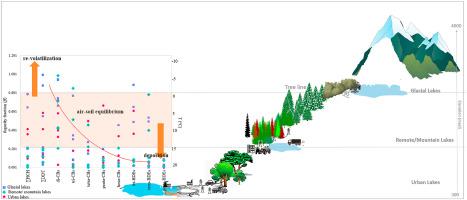Environmental Pollution ( IF 7.6 ) Pub Date : 2021-08-19 , DOI: 10.1016/j.envpol.2021.118006 Rahat Riaz 1 , Riffat Naseem Malik 1 , Cynthia A de Wit 2

|
After decades of imposed regulations about reducing the primary emissions of persistent organic pollutants (POPs), these pollutants are still present in the environment. Soils are important repositories of such persistent semivolatile organic contaminants (SVOCs), and it is assumed that SVOCs sequestered in these reservoirs are being re-mobilized due to anthropogenic influence. In this study, concentrations of organochlorine pesticides (OCPs), polychlorinated biphenyls (PCBs), and polybrominated diphenyl ethers (PBDEs) in soil and air, their fugacities, fluxes and the soil-air partition coefficient (KSA) were determined for three different land cover types (glacial, remote/mountainous and urban) of the Lesser Himalayan Region (LHR). The concentrations of OCPs, PCBs and PBDEs in soils and air ranged between 0.01 and 2.8, 0.81–4.8, 0.089–0.75 ng g−1; 0.2–106, 0.027–182, and 0.011–7.26 pg m−3, respectively. The levels of SVOCs in the soil were correlated with soil organic matter (SOM) indicating that SOM is a substrate for the organic pollutants in soils. The Clausius-Clapeyron plots between ln P and inverse of temperature (1000/T) suggested that long range atmospheric transport was the major input source of PBDEs and higher chlorinated PCBs over the LHR. The uneven and wide distribution of local sources in LHR and up-slope enrichment of SVOCs explained the spatial variability and altitudinal patterns. The soils near mountain and urban lakes act as local sinks of SVOCs such as β-HCH, pp΄-DDT, CB-28, -118, −153, BDE-47, -99, and −154, with soil-air exchange fluxes tending more toward deposition. However, the soils near glacial lakes acted as local sources of more volatile congeners of α-HCH, γ-HCH, op′-DDT, pp′-DDE and lower to medium chlorinated PCBs such as CB-18, -28, −53, −42 and BDE-47, -99, with soil-air exchange tending more toward volatilization flux.
中文翻译:

小喜马拉雅地区半挥发性有机化合物的土壤-空气分配:土壤有机质、大气传输过程和二次排放的影响
经过数十年关于减少持久性有机污染物 (POPs) 初级排放的强制规定,这些污染物仍然存在于环境中。土壤是此类持久性半挥发性有机污染物 (SVOC) 的重要储存库,据推测,由于人为影响,这些储存库中的 SVOC 正在重新流动。在本研究中,土壤和空气中有机氯农药 (OCPs)、多氯联苯 (PCBs) 和多溴联苯醚 (PBDEs) 的浓度、它们的逸度、通量和土壤-空气分配系数 (K SA) 是针对小喜马拉雅地区 (LHR) 的三种不同土地覆盖类型(冰川、偏远/山区和城市)确定的。土壤和空气中OCPs、PCBs和PBDEs的浓度范围为0.01-2.8、0.81-4.8、0.089-0.75 ng g -1;0.2–106、0.027–182 和 0.011–7.26 pg m -3, 分别。土壤中 SVOCs 的水平与土壤有机质 (SOM) 相关,表明 SOM 是土壤中有机污染物的底物。ln P 与温度倒数 (1000/T) 之间的 Clausius-Clapeyron 图表明,长距离大气迁移是 LHR 上 PBDEs 和高氯化 PCBs 的主要输入源。LHR 局部源的不均匀和广泛分布以及 SVOC 的上坡富集解释了空间变异性和海拔模式。山区和城市湖泊附近的土壤是 β-HCH、pp΄等 SVOC 的局部汇-DDT、CB-28、-118、-153、BDE-47、-99 和 -154,土壤-空气交换通量更倾向于沉积。然而,冰川湖附近的土壤是 α-HCH、γ-HCH、op '-DDT、pp ' -DDE和低至中等氯化多氯联苯(如 CB-18、-28、-53)的挥发性同系物的本地来源, -42 和 BDE-47, -99,土壤-空气交换更倾向于挥发通量。











































 京公网安备 11010802027423号
京公网安备 11010802027423号